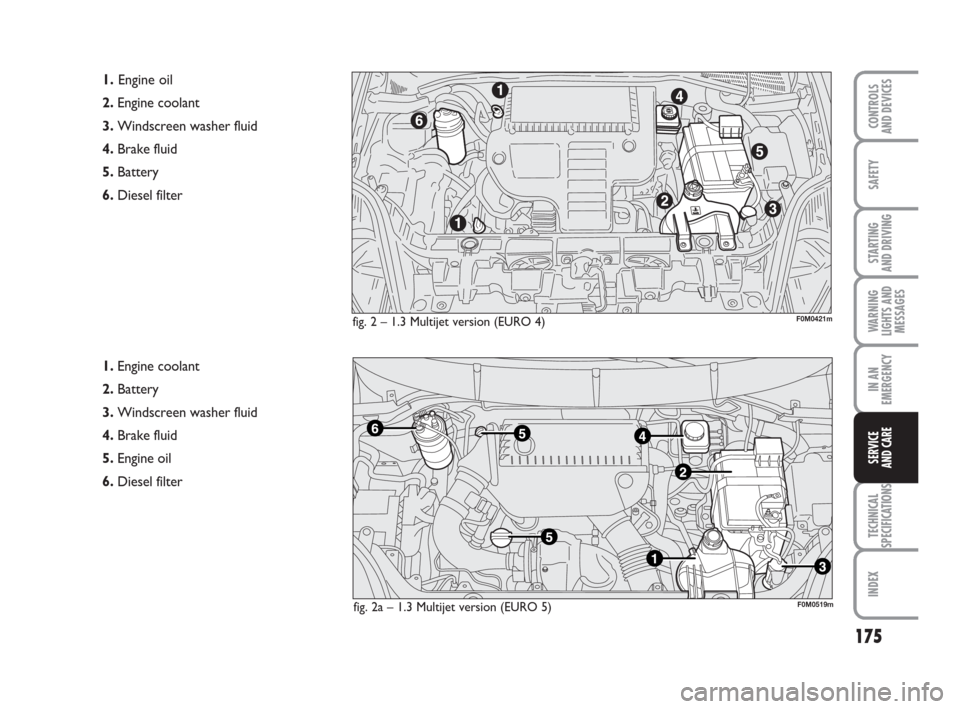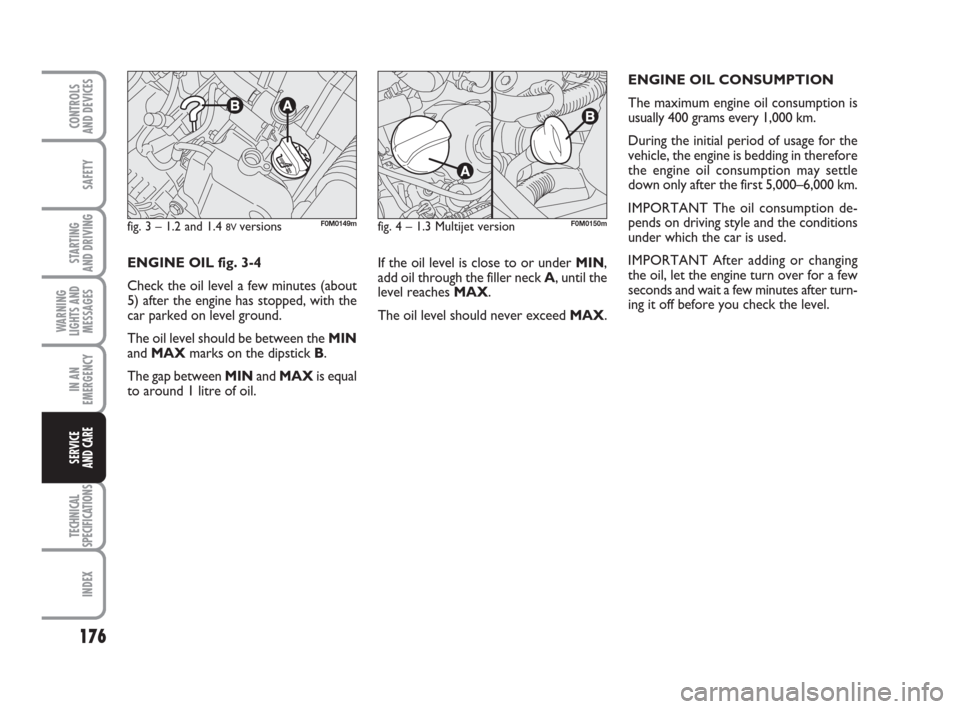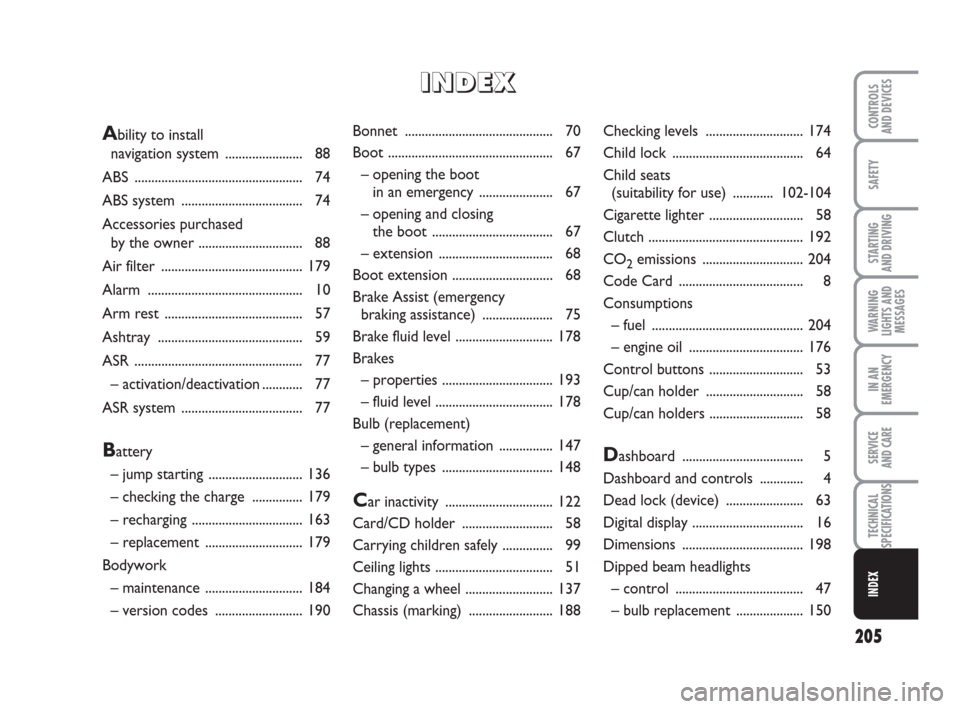2016 FIAT GRANDE PUNTO ACTUAL engine oil
[x] Cancel search: engine oilPage 171 of 216

170
SAFETY
STARTING
AND DRIVING
WARNING
LIGHTS AND
MESSAGES
IN AN
EMERGENCY
TECHNICAL
SPECIFICATIONS
INDEX
CONTROLS
AND DEVICES
SERVICE
AND CARE
If the vehicle is used mainly around town or the annual distance travelled is less than 10,000 km, the engine oil
and oil filter must be changed every 12 months.
Thousands of kilometres
Check exhaust gas emissions
Check battery charge status and possibly recharg
Replace air filter cartridge
Top up fluid levels (engine coolant, brakes,
battery, windscreen washer, etc.)
Check condition of timing belt
Check engine management system operation
(through diagnostic socket)
Replace spark plugs
Replace toothed timing belt (*)
Change engine oil and replace oil filter (or every 24 months)
Change brake fluid (or every 24 months)
Replace pollen filter (or every 24 months)
(*) Regardless of the distance covered, the timing belt should be replaced every 4 years for particularly demanding use (cold climates, city driving, idling for a long
time, dusty areas) or in any case every 5 years.
30 60 90 120 150 180
●●●●● ●
●●●●● ●
●● ●
●●●●● ●
●●
●●●●● ●
●●●●● ●
●
●●●●● ●
●● ●
●●●●● ●
167-186 ACTUAL 1ed EN 18-01-2011 16:31 Pagina 170
Page 173 of 216

172
SAFETY
STARTING
AND DRIVING
WARNING
LIGHTS AND
MESSAGES
IN AN
EMERGENCY
TECHNICAL
SPECIFICATIONS
INDEX
CONTROLS
AND DEVICES
SERVICE
AND CARE
Thousands of kilometres
Check battery charge status and possibly recharg
Check operation of engine management systems
(using diagnostic socket)
Replace accessory drive belt/s
Replace fuel filter
Replace air filter cartridge
Change engine oil and oil filter (Multijet versions without DPF)
(or every 24 months)
Change engine oil and oil filter
(Multijet versions with DPF) (**)
Change brake fluid (or every 24 months)
Replace pollen filter (or every 24 months)
(*) Regardless of the distance covered, the timing belt must be changed every 4 years for particularly demanding use (cold climates, city driving, long periods of
idling) or at least every 5 years.
(**) The engine oil and the filter must be replaced when the warning light on the dashboard comes on (see the “Warning lights and messages” section) or at least
every 24 months.
If the vehicle is used mainly around town or the annual distance travelled is less than 10,000 km, the engine oil
and oil filter must be changed every 12 months.
30 60 90 120 150 180
●●●●● ●
●●●●● ●
●
●● ●
●●●●● ●
●●●●● ●
●● ●
●●●●● ●
167-186 ACTUAL 1ed EN 18-01-2011 14:40 Pagina 172
Page 174 of 216

173
SAFETY
STARTING
AND DRIVING
WARNING
LIGHTS AND
MESSAGES
IN AN
EMERGENCY
TECHNICAL
SPECIFICATIONS
INDEX
CONTROLS
AND DEVICES
SERVICE
AND CARE
DEMANDING USE
OF THE CAR
Should the car be used predominantly in
one of the following particularly demand-
ing conditions:
❒trailer or caravan towing;
❒dusty roads;
❒short (less than 7-8 km) and repeated
journeys in sub-zero temperatures;
❒ frequently idling engine or long-dis-
tance, low-speed driving (e.g. door-to-
door deliveries) or lengthy inactivity;
❒ driving in towns and cities;
you should perform the following inspec-
tions more frequently than shown on the
Scheduled Servicing Plan:
❒ check front disc brake pad conditions
and wear;
❒check cleanliness of bonnet and boot
locks, and cleanliness and lubrication of
linkages;
❒ visually inspect the conditions of: en-
gine, gearbox, transmission, pipes and
tubes (exhaust – fuel – brakes), rubber
parts (boots, sleeves, bushes, etc.);
❒check battery charge and liquid level
(electrolyte);
❒visually inspect the condition of the ac-
cessory drive belts;
❒check pollen filter and replace, if re-
quired;
❒check air filter and replace, if required.
REGULAR CHECKS
Every 1,000 km or before long journeys,
check and, if necessary, top up:
❒engine coolant fluid level;
❒brake fluid level;
❒windscreen washer level;
❒tyre pressure and conditions.
❒operation of lights (headlights, direction
indicators, hazard lights, etc.);
❒operation of the windscreen wiper/
washer system, position and wear of
the windscreen and rear window wiper
blades;
Every 3,000 km, check and top up, if re-
quired, the engine oil level.
You are recommended to use PETRONAS
LUBRICANTS products, which have been
designed and produced specifically for
Fiat cars (see table “Capacities” in the
“Technical specifications” section).
167-186 ACTUAL 1ed EN 27-07-2010 10:30 Pagina 173
Page 175 of 216

174
SAFETY
STARTING
AND DRIVING
WARNING
LIGHTS AND
MESSAGES
IN AN
EMERGENCY
TECHNICAL
SPECIFICATIONS
INDEX
CONTROLS
AND DEVICES
SERVICE
AND CARE
CHECKING LEVELS
fig. 1 – 1.2 (EURO 4) and 1.4 8Vversions
Never smoke while working
in the engine compartment:
inflammable gases and vapours may
be present, constituting a fire risk.
WARNING
When topping up, take care
not to confuse the various
types of fluids: they are not
interchangeable and could se-
riously damage the car.
1. Engine coolant
2. Battery
3. Windscreen washer fluid
4. Brake fluid
5. Engine oil
F0M0418m
fig. 1a - 1.2 (EURO 5) versionsF0M0531m
167-186 ACTUAL 1ed EN 27-07-2010 10:30 Pagina 174
Page 176 of 216

175
SAFETY
STARTING
AND DRIVING
WARNING
LIGHTS AND
MESSAGES
IN AN
EMERGENCY
TECHNICAL
SPECIFICATIONS
INDEX
CONTROLS
AND DEVICES
SERVICE
AND CARE
fig. 2 – 1.3 Multijet version (EURO 4)
1.Engine oil
2. Engine coolant
3. Windscreen washer fluid
4. Brake fluid
5. Battery
6. Diesel filter
1. Engine coolant
2. Battery
3. Windscreen washer fluid
4. Brake fluid
5. Engine oil
6. Diesel filter
F0M0421m
fig. 2a – 1.3 Multijet version (EURO 5)F0M0519m
167-186 ACTUAL 1ed EN 27-07-2010 10:30 Pagina 175
Page 177 of 216

176
SAFETY
STARTING
AND DRIVING
WARNING
LIGHTS AND
MESSAGES
IN AN
EMERGENCY
TECHNICAL
SPECIFICATIONS
INDEX
CONTROLS
AND DEVICES
SERVICE
AND CARE
If the oil level is close to or under MIN,
add oil through the filler neck A, until the
level reaches MAX.
The oil level should never exceed MAX.ENGINE OIL CONSUMPTION
The maximum engine oil consumption is
usually 400 grams every 1,000 km.
During the initial period of usage for the
vehicle, the engine is bedding in therefore
the engine oil consumption may settle
down only after the first 5,000–6,000 km.
IMPORTANT The oil consumption de-
pends on driving style and the conditions
under which the car is used.
IMPORTANT After adding or changing
the oil, let the engine turn over for a few
seconds and wait a few minutes after turn-
ing it off before you check the level. ENGINE OIL fig. 3-4
Check the oil level a few minutes (about
5) after the engine has stopped, with the
car parked on level ground.
The oil level should be between the MIN
and MAXmarks on the dipstick B.
The gap between MINand MAXis equal
to around 1 litre of oil.
fig. 3 – 1.2 and 1.4 8V versions F0M0149mfig. 4 – 1.3 Multijet versionF0M0150m
167-186 ACTUAL 1ed EN 27-07-2010 10:30 Pagina 176
Page 178 of 216

177
SAFETY
STARTING
AND DRIVING
WARNING
LIGHTS AND
MESSAGES
IN AN
EMERGENCY
TECHNICAL
SPECIFICATIONS
INDEX
CONTROLS
AND DEVICES
SERVICE
AND CARE
fig. 5
PARAFLUUPanti-freeze is
used in the engine cooling sys-
tem. Use the same fluid as in
the cooling system when topping up.
PARAFLU
UPmay not be mixed with
any other type of fluid. If this happens,
do not start the engine; contact a Fiat
Dealership.
The cooling system is pres-
surised. If the cap needs re-
placing, do so with another original
or the effectiveness of the system may
be compromised. Do not remove the
cap from the reservoir when the en-
gine is hot: you may get burned
WARNINGENGINE COOLANT fig. 5
The coolant level must be checked when
the engine is cold and must be between
the MINand MAXlines on the vessel.
If the level is low, slowly pour a mixture
of 50% demineralised water and 50%
PARAFLU
UP(made by PETRONAS LU-
BRICANTS) through the filler neck
Auntil the level reaches MAX.
The 50-50 mixture of PARAFLU
UPand
demineralised water gives freeze protec-
tion up to −35 °C.ù
For particularly harsh climate conditions,
a mixture of 60% PARAFLU
UPand 40%
distilled water is recommended.
Used engine oil and the re-
placed oil filter contain sub-
stances that may be harmful
to the environment. It is ad-
visable to have oil and filters changed
by a Fiat Dealership, where they will be
disposed of properly and in accordance
with the law.
Do not add oil with different
characteristics to those of the
existing engine oil.
Be very careful working in
the engine compartment
when the engine is hot: you may get
burned. Remember that the fan may
start up if the engine is hot: this could
injure you. Make sure that scarves,
ties and other loose fitting garments
do not get caught up in moving parts.
WARNING
F0M0424m
167-186 ACTUAL 1ed EN 27-07-2010 10:30 Pagina 177
Page 206 of 216

205
SAFETY
STARTING
AND DRIVING
WARNING
LIGHTS AND
MESSAGES
IN AN
EMERGENCY
SERVICE
AND CARE
TECHNICAL
SPECIFICATIONS
INDEX
CONTROLS
AND DEVICESBonnet ............................................ 70
Boot ................................................. 67
– opening the boot
in an emergency ...................... 67
– opening and closing
the boot .................................... 67
– extension .................................. 68
Boot extension .............................. 68
Brake Assist (emergency
braking assistance) ..................... 75
Brake fluid level ............................. 178
Brakes
– properties ................................. 193
– fluid level ................................... 178
Bulb (replacement)
– general information ................ 147
– bulb types ................................. 148
Car inactivity ................................ 122
Card/CD holder ........................... 58
Carrying children safely ............... 99
Ceiling lights ................................... 51
Changing a wheel .......................... 137
Chassis (marking) ......................... 188Checking levels ............................. 174
Child lock ....................................... 64
Child seats
(suitability for use) ............102-104
Cigarette lighter ............................ 58
Clutch .............................................. 192
CO
2emissions .............................. 204
Code Card ..................................... 8
Consumptions
– fuel ............................................. 204
– engine oil .................................. 176
Control buttons ............................ 53
Cup/can holder ............................. 58
Cup/can holders ............................ 58
Dashboard .................................... 5
Dashboard and controls ............. 4
Dead lock (device) ....................... 63
Digital display ................................. 16
Dimensions .................................... 198
Dipped beam headlights
– control ...................................... 47
– bulb replacement .................... 150
Ability to install
navigation system ....................... 88
ABS .................................................. 74
ABS system .................................... 74
Accessories purchased
by the owner ............................... 88
Air filter .......................................... 179
Alarm .............................................. 10
Arm rest ......................................... 57
Ashtray ........................................... 59
ASR .................................................. 77
– activation/deactivation ............ 77
ASR system .................................... 77
Battery
– jump starting ............................ 136
– checking the charge ............... 179
– recharging ................................. 163
– replacement ............................. 179
Bodywork
– maintenance ............................. 184
– version codes .......................... 190
I I
N N
D D
E E
X X
205-214 ACTUAL 1ed EN 26-07-2010 16:15 Pagina 205